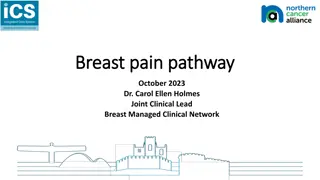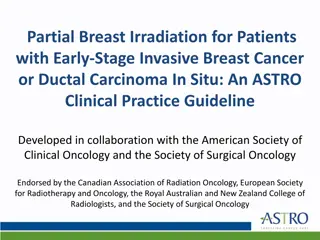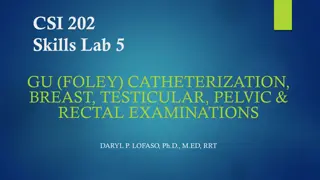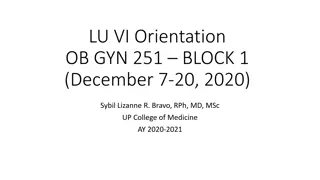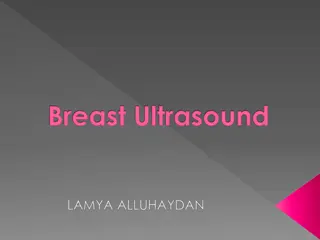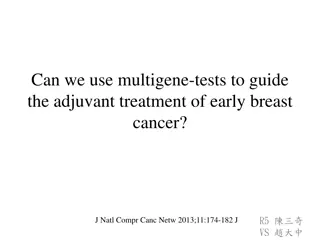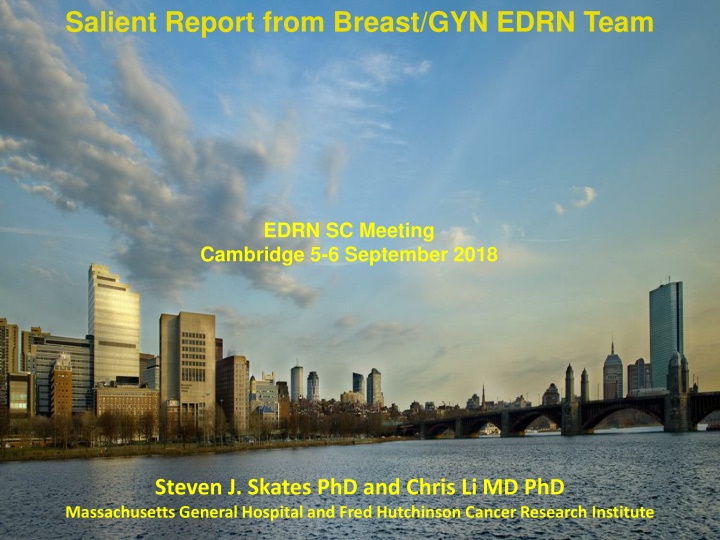
Unique Approach for Early Detection of Breast Cancer Biomarkers
Explore cutting-edge methods combining avatar mice and mass spectrometry to identify blood biomarkers for detecting breast cancer early. Critical questions on funding, imaging, and integrating new biomarkers are addressed to revolutionize cancer screening.
Download Presentation

Please find below an Image/Link to download the presentation.
The content on the website is provided AS IS for your information and personal use only. It may not be sold, licensed, or shared on other websites without obtaining consent from the author. If you encounter any issues during the download, it is possible that the publisher has removed the file from their server.
You are allowed to download the files provided on this website for personal or commercial use, subject to the condition that they are used lawfully. All files are the property of their respective owners.
The content on the website is provided AS IS for your information and personal use only. It may not be sold, licensed, or shared on other websites without obtaining consent from the author.
E N D
Presentation Transcript
Salient Report from Breast/GYN EDRN Team EDRN SC Meeting Cambridge 5-6 September 2018 Steven J. Skates PhD and Chris Li MD PhD Massachusetts General Hospital and Fred Hutchinson Cancer Research Institute Skates 2018 Skates 2018
Summary Breast Cancer Early Detection 1. LaBaer/Anderson detecting auto-antibodies to post-translational modifications (glyco) of plasma proteins (NAPPA) Marks (Duke) and Heine (Moffitt) - Resources for Diagnosing Breast Cancer images and blood biospecimens from 1,000 breast cancer screens Paulovich/Lewis - Combining Avatar Mice and Targeted Mass Spectrometry to Identify Blood Biomarkers for Early Detection of Breast Cancer (detecting human proteins in PDX mice models) Li - Phase 3 Validation of Early Detection Biomarkers for ER+ Breast Cancer 2. 3. 4. Skates 2018 Skates 2018
Critical Questions 1. Infrastructure and funding for early detection studies across multiple cancer sites - far more cost-effective to screen for multiple cancer sites with one blood draw than screening for individual cancer sites (similar in concept to proposed study in cancerSEEK Nature paper) multiple cancer sites 2. 2. Imaging of ovary Imaging of ovary - multiple blood based candidate biomarker exist, multiple longitudinal CA125 studies performed, but Achilles heal is the trans-vaginal sonography - abnormality often not detected on image until too late. Alternatives needing investigation: 1. optical imaging of ovaries via cervix/uterine/fallopian tube flexible scope 2. non-imaging alternatives such as Bhatia's protease method 3. MRI 4. SQUID 3. General population control biospecimen sets - all EDRN teams contribute and all teams have access 4. Health economics impact of screening for 1. 2. each disease site combination of target cancers in one test Skates 2018 Skates 2018
Seconday Critical Questions 1. 2. post-translational modifications of proteins as source of new biomarkers math/stat of integrating information across multiple markers measured at multiple time points new anatomical approaches to biospecimen acquisition for early detection - e.g. uterine lavage for fallopian tube/ovarian cancer incorporating clinical, exposure, and germline genetic risk factors into screening decisions - e.g. higher background risk indicates higher frequency of screening - high density breasts -> more frequent screening methods for amplifying signal - attach nucleic acid barcodes to protein antibodies to leverage PCR for protein assays 3. 4. 5. Skates 2018 Skates 2018
Unique approach combining avatar mice and targeted mass spectrometry to identify blood biomarkers for early detection of breast cancer Amanda Paulovich, M.D., Ph.D. Member, Clinical Research Division Fred Hutchinson Cancer Research Center Michael Lewis, Ph.D. Professor Baylor College of Medicine Steve Skates, Ph.D. Massachusetts General Hospital
Three-stage Experimental Approach Fractionate mouse plasma Shotgun LC-MS/MS Identify human proteins Candidates from PDX mouse Orthotopic PDX Further Prioritization Expressed in breast cancer Not expressed in HMECs Not observed in control plasma (3/3 pools completed) 1,247 candidates Fractionate human plasma Targeted LC-MS/MS Look for 1,247 PDX candidates 6 Breast Cancer Plasma Pools Cancer vs. Control Priority candidates human Assay Assay Validation Clinical Validation Development 25
Duke/Creatv Microtech BDL The goal of this group is to augment diagnostic mammography to reduce the number of breast biopsies The overall approach is to integrate advanced image analysis with candidate circulating biomarkers Prospective collection of >1000 women undergoing breast biopsy triggered by BI-RADS 4 findings (most of the false positive cases are in this category) Prospective study is necessary to conduct concurrent measurement of rare cells (focusing on Cancer Associated Macrophage Like cells) Resource development of matching blood and images from both the prospective and retrospective cohorts Skates 2018
Phase 3 Validation of Early Detection Biomarkers for ER+ Breast Cancer (Li/Lampe) Proteomics Autoantibody/Glycomics CVC2 set asides WHI1 WHI2 Completed CVC1 121 ER+cases 121 controls Completed EDRN Ref Set WHI2 Completed Completed CVC1 90 ER+ cases 90 controls WHI1 EDRN Ref Set 115 ER+ cases 149 controls In progress Completed CVC2 # of markers AAb IgG AAb IgM Glyc SleX Glyc SleA # of markers List Criteria List Criteria A 9 13 11 5 cases/sens 30% A 9 Sens 30%/p 0.2 B 17 7 7 9 cases/sens 30%, cases/sens <30%/p 0.2 B 6 Sens <30%/p 0.2 C 17 A-list markers from WHI2 not validated in the EDRN Ref Set C 39 27 19 18 cases/sens <30%/p 0.2 On proteomics list Skates 2018
JHU BDL (Zhen Zhang/Ie-Ming Shih) Incidence of HGSOC/STIC is much higher than previously thought as evidenced by improved path procedures. Methylation analysis identified tumor-specific alterations readily detectable in early precursor lesions with high accuracy. Adding plasma ctDNA test to pap brush test improves sensitivity to 60+% yet increases FP to 1.3%. Sensitivity for early stage is relatively still low. Using a statistically-principled proteomic analysis to identify candidate biomarkers that 1) are tumor specific, or 2) help to enrich prevalence. The selected candidates will be developed as targeted assays to be analyzed in CVS or UL to assess their ability as a part of IVDMIA to improve DNA-based liquid biopsy tests. Skates 2018
New Biomarkers to improve Early Detection of Ovarian Cancer September 5, 2018 of Ovarian Robert Bast, Karen Lu, Zhen Lu, Wei-Lei Yang (MDACC) Sam Hanash and Makoto Kobayashi (MDACC) Amy Skubitz (U. Minnesota) Steven Skates (MGH)
Antigen-antibody Dissociation Procedure Serum sample (2 l) Dissociation process Antigen 0.1M Glycine-HCl pH3.0 in PBS (48 l) Incubate for 30 min @ RT Zeba Spin Desalting Column (Life Technologies) Buffer exchange process Antigen Immunoglobulins-dissociated serum sample
HE4 Antigen-Autoantibody Complex Assays 72 Early stage cases 213 Healthy controls 98% Specificity HE4 AAbs Case Control Biomarker HE4 CA125 CA125+HE4 (+) 1/72 4/213 (+) 36/72 44/72 62/72 % 1.3% 1.8% % 50.0% 61.1% 86.0%
ROC curve analysis for CA125 with HE4 antigen and CA125 with HE4 antigen-antibody complexes in ovarian cancer cases C D Early stage Late stage pAUC (0.02) pAUC (0.05) Sensitivity (95% C.I.) pAUC (0.02) pAUC (0.05) Sensitivity (95% C.I.) Biomarker AUC (95% C.I.) p-Value Biomarker AUC (95% C.I.) p-Value 0.967 0.92 0.870 0.62 CA125 <0.001 0.02 0.05 CA125 <0.001 0.01 0.03 (0.93 1.00) (0.82 0.98) (0.81 0.92) (0.51 0.74) CA125 + HE4 Ag 0.974 0.90 CA125 + HE4 Ag 0.869 0.62 0.312 0.02 0.05 0.544 0.01 0.03 (0.94 1.00) (0.82 0.98) (0.81 0.92) (0.50 0.74) CA125 + HE4 Ag-Ab 0.985 0.94 CA125 + HE4 Ag-Ab 0.985 0.75 0.003 0.02 0.05 <0.001 0.01 0.04 (0.96 1.00) (0.87 1.00) (0.97 0.99) (0.62 0.94)
CA125 in 3 women with occult ovarian cancer & 3 women without ovarian cancer 1 3 500 2 CA125-II 50 4 6 5 5 88 89 90 91 92 93 94 Year Skates 2018 Skates 2018
ROCA Screening Trials 1. UK Pilot Trial (Barts III) 1995 2001 14,000 normal risk women randomized to screen/ no screen 2. ROCA study 2001 2015 2,400 high risk women, age > 30, CGN/SPORE/EDRN 3. UKCTOCS 2001 - 2015 200,000 normal risk, postmenopausal women randomized to screen/ no screen 4. MDACC study in normal risk women 2001-2011 4,000 normal risk postmenopausal women 1. 2. 3. 4. 5. 6. 7. Jacobs, The Lancet 1988 Skates, JASA 2001 Menon, JCO 2005 Lu, Cancer 2011 Jacobs Menon, The Lancet 2015 Skates, Clinical Cancer Research 2017 Rosenthal, JCO 2017 5. GOG0199 - screening arm 2003-2011 1,600 high risk women, age > 30 UKFOCSS 2003 2013 4,000 high risk women, age > 35 6. Skates 2018 Skates 2018
Olink Proximity Extension Assays (PEAs) Olink Developed nucleic acid barcode for each protein antibody Amplified signal through PCR Accurate and reproducible assays in complex biological fluids (< 15% CV) from minimal volume 2 uL Developed PEAs assays for 1,008 proteins (11 Panels) Evaluated in longitudinal samples from our screening trials Skates 2018 Skates 2018
MUC16 Q8WXI7 Olink Analysis of Selected GOG&CGN Samples (13 cases and 13 matched controls) MUC 16 Q8WXI7 case & control 1 case & control 2 case & control 3 case & control 4 case & control 5 (Peritoneal carcinomatosis, Stage 4) (Serous Adenocarcinoma, Stage 2A) (Serous Adenocarcinoma, Stage 3) (Serous Adenocarcinoma, Stage 4B) (mixed endometrioid and serous carcinoma, Stage 2B) Case Control LOD_case LOD_control Case Control LOD_case LOD_control Case Control LOD_case LOD_control Case Control LOD_case LOD_control Case Control LOD_case LOD_control Dx at Age 40 Dx at Age 62 Dx at Age 42 Dx at Age 51 Dx at Age 41 case & control 6 case & control 7 case & control 8 case & control 9 case & control 10 (Serous Adenocarcinoma, Stage 3C) (Adenocarcinoma, Unsp, Stage 1C) (Serous Adenocarcinoma, Stage 1C) (Serous Adenocarcinoma, Stage 3C) (Undifferentiated Carcinoma, Stage 2A) Case Control LOD_case LOD_control Case Control LOD_case LOD_control Case Control LOD_case LOD_control Case Control LOD_case LOD_control Case Control LOD_case LOD_control Dx at Age 65 Dx at Age 50 Dx at Age 49 Dx at Age 46 Dx at Age 42 0 1 2 3 4 0 1 2 3 4 case & control 11 case & control 12 case & control 13 (Serous Adenocarcinoma, Stage 3C) (Serous Adenocarcinoma, Stage 3C) (Serous Adenocarcinoma, Stage 3C) Case Control LOD_case LOD_control Case Control LOD_case LOD_control Case Control LOD_case LOD_control Dx at Age 49 Dx at Age 81 Dx at Age 64 0 1 2 3 4 0 1 2 3 4 0 1 2 3 4 Skates 2018 Skates 2018
TACSTD2 P09758 Olink Analysis of Selected GOG&CGN Samples (13 cases and 13 matched controls) TACSTD2 P09758 case & control 1 case & control 2 case & control 3 case & control 4 case & control 5 (Peritoneal carcinomatosis, Stage 4) (Serous Adenocarcinoma, Stage 2A) (Serous Adenocarcinoma, Stage 3) (Serous Adenocarcinoma, Stage 4B) (mixed endometrioid and serous carcinoma, Stage 2B) Case Control LOD_case LOD_control Case Control LOD_case LOD_control Case Control LOD_case LOD_control Case Control LOD_case LOD_control Case Control LOD_case LOD_control Dx at Age 40 Dx at Age 62 Dx at Age 42 Dx at Age 51 Dx at Age 41 case & control 6 case & control 7 case & control 8 case & control 9 case & control 10 (Serous Adenocarcinoma, Stage 3C) (Adenocarcinoma, Unsp, Stage 1C) (Serous Adenocarcinoma, Stage 1C) (Serous Adenocarcinoma, Stage 3C) (Undifferentiated Carcinoma, Stage 2A) Case Control LOD_case LOD_control Case Control LOD_case LOD_control Case Control LOD_case LOD_control Case Control LOD_case LOD_control Case Control LOD_case LOD_control Dx at Age 65 Dx at Age 50 Dx at Age 49 Dx at Age 46 Dx at Age 42 0 1 2 3 4 0 1 2 3 4 case & control 11 case & control 12 case & control 13 (Serous Adenocarcinoma, Stage 3C) (Serous Adenocarcinoma, Stage 3C) (Serous Adenocarcinoma, Stage 3C) Case Control LOD_case LOD_control Case Control LOD_case LOD_control Case Control LOD_case LOD_control Dx at Age 49 Dx at Age 81 Dx at Age 64 0 1 2 3 4 0 1 2 3 4 0 1 2 3 4 Skates 2018 Skates 2018
Promising Candidate Plasma Early Detection Ovarian Cancer Biomarkers Promising: 2 standard, 5 new TACSTD2 P09758 CSTB P04080 MUC 16 Q8WXI7 (CA-125) WFDC2 Q14508 (HE4) FGF 21 Q9NSA1 CDH6 P55285 34 potential other candidates EPO P01588 Skates 2018 Skates 2018
Rank of Olink identified candidates case 1 case 2 case 3 case 4 case 5 case 6 case 7 case 8 case 9 case 10 case 11 case 12 case 13 Assay Uniprot Q8WXI7 Q01638 Q14508 P35442 P16278 Q9H5V8 P55285 P07711 P05164 P09758 P48740 Q07011 O00592 Q9NSA1 P16284 P08727 Q2VWP7 Q08345 Q99523 P02462 Q16653 Q9UNE0 P78310 P37023 P05231 Q9UIB8 Q9BYF1 P04080 P04275 P21583 P25942 P16083 P08473 P01588 P09238 Q96LA6 Q9HBB8 P80098 P30838 P18627 O75356 MUC 16 ST2 WFDC2 THBS2 GLB1 CDCP1 CDH6 CTSL1 MPO TACSTD2 MASP1 TNFRSF9 PODXL FGF 21 PECAM 1 KRT19 PRTG DDR1 SORT1 COL4A1 MOG EDAR CXADR SKR3 IL6 CD84 ACE2 CSTB vWF SCF CD40 NQO2 NEP EPO MMP 10 FCRL1 CDHR5 MCP 3 ALDH3A1 LAG3 ENTPD 1 1 1 1 0 1 1 1 0 1 1 1 1 1 0 1 0 1 1 1 1 0 1 1 1 0 0 0 0 0 0 0 0 1 1 1 1 0 0 0 0 1 1 0 1 1 1 1 1 1 1 0 0 1 0 0 1 1 1 0 1 1 0 1 0 0 0 1 1 1 0 1 0 1 1 0 0 0 0 0 0 0 0 0 0 0 0 0 0 0 0 0 0 0 0 1 0 0 0 0 0 0 0 0 0 0 0 0 0 0 0 0 0 0 0 0 0 0 0 0 0 0 0 1 1 1 1 1 1 0 1 1 0 1 1 1 0 1 1 0 0 1 0 0 1 1 0 1 1 1 1 0 1 1 1 0 0 1 0 1 1 1 0 0 1 1 1 1 1 0 1 1 1 1 1 0 0 0 1 1 1 1 1 1 0 0 1 1 0 0 1 0 1 0 0 0 1 1 0 1 1 0 0 1 1 1 0 1 0 1 1 1 0 0 0 1 1 1 0 1 0 1 0 1 0 0 0 0 0 0 0 0 1 0 1 0 1 0 0 0 0 0 0 0 0 0 0 0 0 1 1 0 1 0 0 0 0 1 0 1 1 1 0 0 0 0 0 1 0 1 1 1 0 0 0 0 0 0 0 0 0 0 0 0 1 0 0 0 1 0 0 0 1 1 1 0 0 1 0 0 0 0 0 0 0 0 0 0 0 0 0 0 0 1 0 0 0 0 1 1 0 0 0 0 0 0 0 0 1 1 1 1 0 0 0 0 1 1 0 0 1 1 1 1 1 0 0 0 0 1 0 1 0 1 0 1 1 0 1 1 0 0 1 0 0 0 0 0 0 1 1 1 0 1 1 1 1 1 1 1 1 0 1 0 0 1 1 1 1 1 0 0 1 1 0 0 0 0 1 1 0 1 0 0 1 0 0 0 0 0 1 0 1 1 0 0 0 0 1 0 0 0 0 0 0 0 0 0 0 0 1 0 0 0 0 0 0 0 0 0 0 0 0 0 0 0 0 0 0 0 0 1 1 1 1 1 1 1 1 0 1 1 1 1 0 1 0 1 1 0 1 0 1 1 0 0 1 0 0 1 0 0 0 0 1 0 0 0 0 0 0 0 1 1 1 0 1 1 0 0 1 1 0 1 1 1 0 0 0 1 0 0 1 1 0 0 0 0 0 0 0 1 0 0 0 0 0 0 0 1 0 0 0 10 9 9 8 8 8 8 7 7 7 7 7 7 6 6 6 6 6 5 5 5 5 5 5 4 4 4 4 4 4 4 4 4 4 3 3 3 2 2 1 1 Sum - best 7 6 5 1 3 5 4 2 1 5 5 2 5 4 Sum - all 40 24 22 1 27 26 14 12 8 19 23 5 21 15 Skates 2018 Skates 2018
Promising Candidate Plasma Early Detection Ovarian Cancer Biomarkers Promising: 2 standard, 5 new TACSTD2 P09758 CSTB P04080 MUC 16 Q8WXI7 (CA-125) WFDC2 Q14508 (HE4) FGF 21 Q9NSA1 CDH6 P55285 34 potential other candidates EPO P01588 Skates 2018 Skates 2018
Critical Questions 1. Infrastructure and funding for early detection studies across multiple cancer sites - far more cost-effective to screen for multiple cancer sites with one blood draw than screening for individual cancer sites (similar in concept to proposed study in cancerSEEK Nature paper) multiple cancer sites 2. 2. Imaging of ovary Imaging of ovary - multiple blood based candidate biomarker exist, multiple longitudinal CA125 studies performed, but Achilles heal is the trans-vaginal sonography - abnormality often not detected on image until too late. Alternatives needing investigation: 1. optical imaging of ovaries via cervix/uterine/fallopian tube flexible scope 2. non-imaging alternatives such as Bhatia's protease method 3. MRI 4. SQUID 3. General population control biospecimen sets - all EDRN teams contribute and all teams have access 4. Health economics impact of screening for 1. 2. each disease site combination of target cancers in one test Skates 2018 Skates 2018



